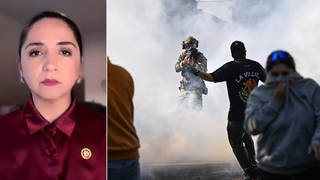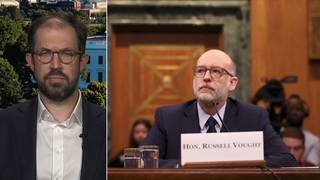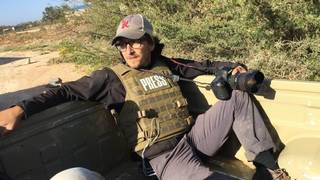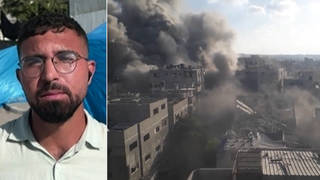
Topics
Today is the fifth anniversary of the first prisoners being sent to the U.S. prison camp at Guantanamo Bay, Cuba. Since then, more than 750 men and boys from 40 countries have been imprisoned at there. Not one of them has been put on trial. Hundreds have been released without charge and sent home. Three have committed suicide, at least 40 others have tried to do so. We look back at some of our coverage over the years, including interviews with former Guantanamo detainees and interrogators, attorneys, human rights activists and more. [includes rush transcript]
Transcript
AMY GOODMAN: Today is also the fifth anniversary of the first prisoners being sent to the U.S. prison camp at Guantanamo Bay, Cuba. On January 11, 2002, 20 men in handcuffs, shackles, wearing hoods, arrived at Guantanamo in a plane from Afghanistan. The Bush administration created a new category of “enemy combatant” for these men captured in the so-called war on terror. Since then, more than 750 men and boys from 40 countries have been imprisoned at Guantanamo. Not one of them has been put on trial. Hundreds have been released and sent home. Meanwhile, three have committed suicide, at least 40 others have tried to do so. There are concerns about the mental health of most of the 400 or so remaining prisoners. Accounts of prisoner abuse and torture have been condemned around the world.
Today, people are coming together across the country and the globe in an international day of action to shut down Guantánamo. In a few minutes we’ll speak with a former Guantanamo detainee who is currently in Cuba as part of an international delegation calling for the closure of the prison camp, as well as the brother of a Guantanamo prisoner who has been held there since 2002.
But first, we go back to some of our coverage of Guantanamo over the last five years. Democracy Now! has closely followed the story. We have interviewed former Guantanamo prisoners and interrogators, dozens of attorneys, human rights activists and more. These are some of the voices. They include Joshua Colangelo-Bryan, a lawyer who witnessed his client’s suicide attempt during a visit to the camp; Professor Alfred McCoy, author of A Question of Torture; Guantanamo translator Erik Saar; attorney Julia Tarver; and Azmat Begg, whose son Moazzam was imprisoned at Guantanamo. But we begin with James Yee, a Muslim chaplain who served at Guantanamo, was later imprisoned himself, though all charges were later dropped against him.
JAMES YEE: [Click for full interview] Now, what was Gitmo’s secret weapon? Well, from the viewpoint of a chaplain in the United States military whose role is essentially to advocate for the free exercise of worship, Gitmo’s secret weapon was the use of religion against the prisoners, whether to try and break them or frustrate them in the course of trying to glean information from them or in the course of detaining them. Now, how was religion being used against the prisoners? Well, prisoners would come and they would tell me that when they were taken to interrogation, they were, of course, shackled at the wrists and at the waist and at the ankles, as prisoners down in Guantanamo are shackled, and they would tell me that they would be forced to sit in the center of what was painted on the floor, a satanic circle. The interrogators would attempt to force them to bow down and prostrate, you know, like in the form of the Islamic prayer where Muslims bow down and prostrate, while the interrogator is screaming at that prisoner that “Satan is your god now, not Allah!”
ALFRED McCOY: [Click for full interview] One of the things that Donald Rumsfeld did, right at the start of the war of terror, in late 2002, he appointed General Geoffrey Miller to be chief at Guantanamo, all right, because the previous commanders at Guantanamo were too soft on the detainees, and General Miller turned Guantanamo into a de facto behavioral research laboratory, a kind of torture research laboratory. And under General Miller at Guantanamo, they perfected the CIA torture paradigm. They added two key techniques. They went beyond the universal sensory receptors of the original research. They added to it an attack on cultural sensitivity, particularly Arab male sensitivity to issues of gender and sexual identity. And then they went further still. Under General Miller, they created these things called “biscuit” teams, behavioral science consultation teams, and they actually had qualified military psychologists participating in the ongoing interrogation, and these psychologists would identify individual phobias, like fear of dark or attachment to mother, and by the time we’re done, by 2003, under General Miller, Guantanamo had perfected the CIA paradigm, and it had a threefold total assault on the human psyche: sensory receptors, self-inflicted pain, cultural sensitivity, and individual fears and phobia.
ERIK SAAR: [Click for full interview] That day, a technique was used in the interrogation booth where sex was used as a weapon to create a wedge between the detainee we were speaking with and his faith. For example, more specifically, the female interrogator I worked with that day sought to sexually entice the detainee. The logic behind that was that if he would be sexually attracted to her, he would feel unclean, and therefore, she believed, in Islam, he would be unable to go back to his cell and pray. One thing she additionally did in order to humiliate him and also to make him feel unclean was wipe what was red ink on his face, but it was done in a way that he believed it was menstrual blood. All of this again was in an attempt to create this wedge between himself and his religion, and not only was it ineffective, but I thought it was unethical.
JAMES YEE: [Click for full interview] The detainees would tell me things that they experienced in interrogation, what they went through, and one complaint actually caused a lot of turmoil, disturbance and riots, led to suicide attempts. And that was when an interrogator actually came back into the camp from a detainee who had been interrogated, that his interrogator had actually taken the Qur’an and kicked it across the floor. Now, this spread throughout the camp and upset the entire population of Muslim prisoners. They protested, and it led to mass riots and repeated suicide attempts.
JOSHUA COLANGELO-BRYAN: [Click for full transcript] The MPs arrived. I left the room. Several minutes later, the MPs came out after having moved Jumah into the cell. After a few moments, I decided that I should check and see whether he was finished, so that I could come in and speak with him again. I opened the door to the room that houses both the meeting area and the cell. The first thing I saw was a pool of blood on the floor. And strangely, in that first moment, my initial thought was that he had made himself vomit blood, because this is a symptom that he has complained about. And I had the strange thought that maybe he was trying to convince me that it was a genuine symptom and not something that he had made up. A second later, I looked toward the area of the cell, however, and saw Jumah hanging by his neck from the top of a mesh metal wall that encloses the cell. He also had what appeared to be a very serious gash on the inside of his right arm, which was causing him to bleed on himself and also on the floor.
JULIA TARVER: [Click for full interview] The level of hopelessness in the camp has reached a point where our clients are literally vowing they have no other choice but to die. The treatment they’re receiving from the guards and the medical staff at Guantanamo is very, very disturbing. What we’ve learned is that in some sort of ill-advised attempt to stop the hunger strike, the guards and the medical staff are using intervention, medical intervention, to actually inflict forms of torture on our clients. They claim that in order to preserve life at the base, they are inserting tubes into the clients’ noses that go down into their stomachs, and they’re able to be fed that way. But the problem is the clients have told us horrific stories, repeatedly, from different clients, about how these same tubes are being forcibly inserted in by riot guards, how they’re taken from one detainee and inserted into the next detainee with no sanitization, with the bile and the blood still on the tube from the previous detainee.
AZMAT BEGG: [Click for full transcript] They transferred him to Guantanamo Bay. He was badly treated. He was deprived of proper food. He was deprived of natural light: sun, moon, or anything. He says, “I haven’t seen sun, moon, or sky for the last whole one year, except for two minutes. I’m being treated like an animal. They pull me and push me into cages, and that’s how I am here now. At times I don’t get food and my clothes are torn. They don’t care, and I don’t know whom to go to.”
AMY GOODMAN: Azmat Begg, describing a letter from his son Moazzam, who was imprisoned for three years by U.S. forces at Guantanamo, at Bagram and at Kandahar. In January 2005, Moazzam Begg was released. Our hour-long interview with him is available on our website at democracynow.org. When we come back from break, we’re going to Cuba, where we will speak with a former prisoner back in Cuba to protest the Guantanamo prison camp. We’ll also speak with the brother of a current detainee. Stay with us.












Media Options